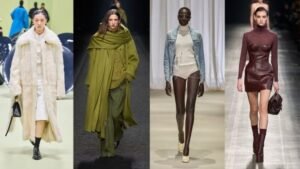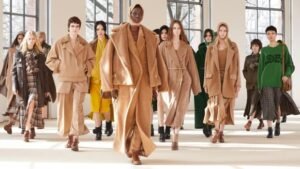The fashion industry is like an iceberg—what we see on the surface is only a small fraction of its true scope. Below the surface lies an intricate network of designers, manufacturers, marketers, consumers, and global trade practices that all work together to create what we know as fashion. In this comprehensive guide, we’ll take a deep dive into the Fashion Iceberg, exploring its various layers, from the highly visible aspects to the hidden factors that influence the industry.
Whether you are a fashion enthusiast, a consumer, or someone interested in the business of fashion, this article will provide you with a well-rounded view of the fashion landscape.
Table of Contents
- Introduction to the Fashion Iceberg
- The Visible Top Layer of Fashion
- Fashion Trends and Styles
- Celebrity Influence on Fashion
- Fashion Week and Global Runways
- The Middle Layer: The Manufacturing Process
- The Role of Manufacturers
- Fast Fashion vs. Sustainable Fashion
- The Hidden Layers: Supply Chain and Labor Practices
- The Global Fashion Supply Chain
- Ethical Fashion and Fair Labor Practices
- Impact of Fashion on Society and the Environment
- Environmental Impact
- Social Impacts: Diversity and Representation
- The Economic Layer of Fashion
- The Global Fashion Market
- Fashion’s Role in the Economy
- The Digital Revolution in Fashion
- E-Commerce and Fashion Websites
- The Role of Social Media in Fashion Trends
- Fashion and the Future: Sustainability and Innovation
- Sustainable Fashion Innovations
- The Future of Fashion
- Important Facts and Statistics (Table)
- Conclusion
- Disclaimer

1. Introduction to the Fashion Iceberg
The concept of the “fashion iceberg” refers to the complex, layered nature of the fashion industry. On the surface, we see the clothing we wear, the latest runway trends, and the celebrity endorsements. However, much like an iceberg, the majority of the fashion industry remains unseen. Beneath the surface, a vast web of supply chains, labor practices, environmental concerns, and business economics shape the industry.
Fashion is often thought of as a creative pursuit, but it is also an enormous global business with far-reaching implications. Understanding the layers of the fashion iceberg helps us to navigate the industry with greater awareness of its impact and the forces at play.
2. The Visible Top Layer of Fashion
Fashion Trends and Styles
The most obvious aspect of the fashion iceberg is the clothes we wear and the trends that define them. From the latest streetwear styles to haute couture fashion shows, these trends are visible to everyone. Fashion trends are influenced by several factors, including cultural movements, social media, and celebrity endorsements.
Celebrity Influence on Fashion
Celebrities play a crucial role in shaping fashion trends. Their influence extends beyond just clothing choices, as they can impact the popularity of brands and designers. For instance, a celebrity wearing a specific designer or brand can cause a spike in sales, making it a significant aspect of fashion marketing.
Fashion Week and Global Runways
Fashion weeks held in major cities like New York, Paris, Milan, and London are key events in the fashion calendar. These weeks showcase the upcoming trends for each season, and many designers use these runways as platforms to introduce their latest collections to the world.

3. The Middle Layer: The Manufacturing Process
The Role of Manufacturers
Behind every piece of clothing, there is a manufacturer who produces the fabric, cuts and stitches it together, and prepares it for distribution. Many fashion brands outsource manufacturing to countries with lower production costs, such as China, Bangladesh, and India.
This layer of the iceberg is crucial in understanding the economics of fashion. While high-end brands may have their own manufacturing processes in place, fast fashion companies often rely on mass production in lower-cost countries.
Fast Fashion vs. Sustainable Fashion
The rise of fast fashion has been one of the most significant trends in the fashion industry over the past few decades. Fast fashion refers to the rapid production of cheap, trendy clothing that is quickly brought to market. Brands like Zara, H&M, and Forever 21 epitomize this trend.
In contrast, sustainable fashion seeks to create clothing that is environmentally friendly, ethically made, and of higher quality. Sustainable fashion focuses on reducing waste, using eco-friendly materials, and ensuring fair labor practices throughout the supply chain.
4. The Hidden Layers: Supply Chain and Labor Practices
The Global Fashion Supply Chain
The fashion supply chain is a global network that involves various stages, including the sourcing of raw materials, the manufacturing process, shipping, and retail. The supply chain is often opaque, with brands focusing on the final product rather than the journey it takes to get there.
For example, cotton grown in India may be spun into yarn in China, dyed in Bangladesh, and sewn into garments in Vietnam. These garments are then shipped globally, often with minimal regard for the workers involved or the environmental impact of the processes.
Ethical Fashion and Fair Labor Practices
Labor exploitation is a key issue in the fashion industry. Many workers in developing countries are paid very low wages and work in unsafe conditions. Ethical fashion aims to improve these conditions by ensuring fair wages, safe working environments, and adherence to labor rights.

5. Impact of Fashion on Society and the Environment
Environmental Impact
Fashion has a significant environmental footprint. The industry is responsible for a large percentage of global pollution, including water waste, chemical runoff, and carbon emissions. Additionally, fast fashion contributes to the massive amount of textile waste that ends up in landfills each year.
Social Impacts: Diversity and Representation
Fashion has long been criticized for its lack of diversity and representation, particularly in terms of race, body size, and gender. However, in recent years, there has been a push towards greater inclusivity, with many designers and brands making efforts to showcase a broader range of models and perspectives.
6. The Economic Layer of Fashion
The Global Fashion Market
Fashion is a multi-trillion-dollar industry, with a global market that encompasses everything from luxury goods to budget-friendly apparel. According to industry reports, the global fashion industry is worth over $2.5 trillion. This massive market is fueled by consumer demand, with people around the world spending billions annually on clothing, accessories, and footwear.
Fashion’s Role in the Economy
The fashion industry plays a significant role in the economy, providing jobs for millions of people worldwide. From garment workers to designers, marketers, and retail employees, fashion supports a vast network of professionals. Furthermore, the industry also contributes to global trade, with countries exporting and importing fashion goods regularly.
7. The Digital Revolution in Fashion
E-Commerce and Fashion Websites
With the rise of e-commerce, shopping for fashion has become more accessible than ever. Online platforms like Amazon, ASOS, and Zalando have revolutionized how consumers purchase clothing, offering a vast selection of products at the click of a button.
Social media has also played a huge role in fashion, with platforms like Instagram, TikTok, and Pinterest allowing users to discover new trends, brands, and influencers.
The Role of Social Media in Fashion Trends
Social media has changed the way trends emerge and spread. Influencers, bloggers, and even everyday consumers can impact what is considered fashionable through their online presence. Hashtags, viral challenges, and user-generated content all contribute to the way fashion evolves in the digital age.
8. Fashion and the Future: Sustainability and Innovation
Sustainable Fashion Innovations
The future of fashion lies in sustainability. Many designers and companies are investing in innovative materials, such as biodegradable fabrics, recycled fibers, and plant-based textiles. These innovations aim to reduce the environmental impact of fashion while also providing consumers with eco-friendly alternatives.
The Future of Fashion
As sustainability continues to shape the fashion industry, we can expect more transparent supply chains, eco-conscious production methods, and a move away from the fast fashion model. Consumers will also play a crucial role in the future of fashion by demanding ethical practices and supporting brands that prioritize sustainability.
9. Important Facts and Statistics (Table)
| Fact/Statistic | Value/Details |
|---|---|
| Global Fashion Market Value | $2.5 trillion (2020 estimate) |
| Annual Textile Waste | 92 million tons worldwide |
| Percentage of Fashion Industry’s Carbon Emissions | 10% |
| Percentage of Fashion Workers in Developing Countries | 80% |
| Growth of Sustainable Fashion Market | Expected to grow by 10% annually over the next 5 years |
10. Conclusion
The fashion iceberg offers a unique perspective on the complexities of the industry. While the top layer showcases the trends, celebrities, and runways we’re all familiar with, the layers beneath are what truly shape the industry. From global supply chains and labor practices to environmental impacts and technological innovations, fashion is more than just clothing—it’s a global system that affects millions of lives.
As consumers, it’s important to be aware of the full scope of the fashion iceberg. By understanding the hidden layers, we can make more informed choices and support brands that are driving positive change in the industry.
Disclaimer
The information presented in this article is for informational purposes only. The views and opinions expressed are those of the author and do not necessarily reflect the official policy or position of any organization, company, or brand mentioned. Fashion is a rapidly changing industry, and some facts may evolve over time. Always consult with trusted sources for the most up-to-date information.
